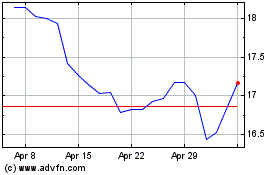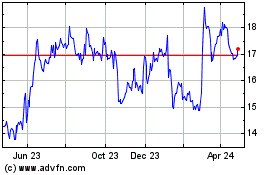HPE Edge Orchestrator enables telcos to monetize 5G networks and
edge infrastructure by delivering new low latency cloud services at
the edge via an app catalog
Hewlett Packard Enterprise (HPE) today announced HPE Edge Orchestrator, a SaaS-based offering that
enables telcos to deploy innovative new edge computing services to
customers via IT infrastructure located at the edge of telco
networks or on customer premises. With the HPE Edge Orchestrator
solution, telcos can extend their offerings to include a catalog of
edge computing applications which customers can deploy with a
single click, across hundreds of locations. HPE Edge Orchestrator
enables telcos to monetize the 5G network and telco cloud while
bringing lower latency, increased security and enhanced end-user
experiences to their customers.
Analysts expect the next decade to see the rise of edge
computing where data intensive workloads such as AI, machine
learning (ML), augmented and virtual reality apps will be hosted at
the edge. Telcos already have thousands of edge sites powering
mobile and fixed networks, so they are uniquely positioned to lead
the edge services market. In fact according to a recent IDC study1,
40% of enterprises trust their telco to be their main provider of
edge solutions. However, until now telcos haven’t had the tools to
do this themselves without relying on public cloud providers.
HPE Edge Orchestrator gives the power back to telcos. Now they
can offer value-added edge services in their own right and can move
from being primarily bandwidth providers to offering innovative
edge computing applications, such as AI-powered video analytics,
industrial automation and VR retail services. New revenue from
these high-value enterprise services will also help to cover the
significant cost of deploying new 5G infrastructure.
Following the launch of HPE’s open 5G portfolio and introduction
of the cloud-native HPE 5G Core Stack, HPE Edge Orchestrator
enables telcos to drive new revenue streams at the edge of telecom
networks. HPE Edge Orchestrator unleashes the deployment and
configuration of customer applications, provided as virtual
machines or containers, at geographically-distributed edge
locations owned by telcos, such as existing central offices or on
customer premises. Customers can access edge applications via a
self-service app catalog for simple management, monitoring and the
deployment of an app to an edge device with one-click
operation.
“Today, telcos have significant enterprise business, but they
are often seen as little more than bandwidth providers, competing
mostly on price,” said Phil Mottram, Vice President and General
Manager of the Communications and Media Solutions business unit at
HPE. “HPE Edge Orchestrator empowers telcos to move up the value
chain and become trusted edge services providers, offering
differentiated, high-value enterprise services as well as new edge
applications for their mobile subscribers. Furthermore, telcos will
be positioned to compete more effectively with cloud and
over-the-top competitors.”
HPE Edge Orchestrator enables enterprises to easily combine
their applications with network services offered by telcos, thus
creating an end-to-end flow across the edge. Today, HPE Edge
Orchestrator supports Multi-access Edge Computing (MEC) with other
network-as-a-service (NaaS) functions being added to the catalog
over time. The MEC platform enables applications to run at the
edge, while delivering network services that ensure a dynamic
routing of edge traffic in 4G, 5G and Wi-Fi environments.
“Telcos are uniquely positioned to facilitate digital change by
connecting people, enterprises and society, enabling new classes of
services,” explains Martina Kurth, Associate Vice President for
IDC’s European Telco Research. “Telcos need to change the way they
operate and become part of the value creation with 5G and edge
computing. New technologies like HPE Edge Orchestrator will help
telcos to tap into new digital business models and play an
important role in evolving enterprise ecosystems.”
To capitalize on the edge services opportunity, telcos need to
bring applications from the cloud out to the edge where the data
exists. With HPE Edge Orchestrator, along with HPE Edgeline and ProLiant servers, telcos can position application
intelligence at the edge and unlock major business benefits for
their customers:
- Lower latency: When applications can process requests
locally instead of routing them to a data center, they can deliver
much better performance. This translates to a better user
experience for any business application. For the new generation of
ultra-low-latency use cases like augmented reality and industrial
automation, short round-trip times are absolutely essential.
- Bandwidth optimization: Positioning application
intelligence out at the edge, such as doing number-crunching closer
to where the numbers are generated, greatly reduces the wide-area
network (WAN) bandwidth the application requires. This translates
to lower WAN costs for businesses and less traffic congestion in
telco core and metro networks. Applications like video analytics
become much more efficient and, as a result, applicable to use
cases that might not have been viable in the past.
- Improved security and privacy: Any time businesses
transmit data over a network, they’re potentially exposing it to
security threats. For the most sensitive information, some
businesses want to keep everything onsite. In regions with strict
privacy protections like the European Union, some applications may
simply not be viable unless they can process all personally
identifiable information (PII) locally.
The key to making telcos’ edge computing deployments successful
for both the operator and their enterprise customers lies in
ensuring that applications running at the edge are easy to deploy
and manage across many sites. With the recently announced Open
Distributed Infrastructure Management initiative, HPE is
simplifying the management of physical infrastructure deployments
from core to edge. Now HPE Edge Orchestrator is enabling telcos to
deliver new, targeted vertical solutions and enterprise
applications —all centrally manageable across thousands of
distributed locations through simple self-service tools.
New edge computing offerings start with compute platforms
optimized for deployment at remote operator sites (central offices,
radio towers, other point of presence (POP) locations), or even
directly at the customer premises. For example, HPE Edgeline
Converged Edge Servers, such as the EL4000 and EL8000, have been
specifically designed to run at the edge. Platforms like these host
all of the components needed to manage the edge computing workloads
in containers or VMs. HPE Edge Orchestrator provides a centralized,
comprehensive, hardware agnostic orchestration platform to
provision, configure, and perform general management functions for
all components of edge computing. HPE Edge Orchestrator is also
multi-tenant by design. Telcos can give diverse enterprise
customers their own “private” interfaces to manage their workloads,
sites, edge devices, and services, while their own teams manage the
entire CSP edge computing portfolio as a single system. HPE Edge
Orchestrator can also work in conjunction with the recently
announced Aruba Edge Services Platform (ESP), enabling enterprises
to easily integrate both Wi-Fi-based and telco services.
HPE – a trusted and proven partner to telcos
HPE has over 30 years of experience in the telecoms industry,
with more than 300 telco customers in 160 countries. In the core,
700 million subscribers across 82 carriers depend on HPE Mobile
Core software, and HPE was recently recognized by Frost &
Sullivan with the 2019 Leadership award for Global 5G
Infrastructure Enabling Technology. Learn more at:
https://www.hpe.com/us/en/solutions/communications-industry-transformation.html
Availability
HPE Edge Orchestrator will be available as a Service to telcos
from July 31, 2020.
About Hewlett Packard Enterprise
Hewlett Packard Enterprise is the global edge-to-cloud
platform-as-a-service company that helps organizations accelerate
outcomes by unlocking value from all of their data, everywhere.
Built on decades of reimagining the future and innovating to
advance the way we live and work, HPE delivers unique, open and
intelligent technology solutions, with a consistent experience
across all clouds and edges, to help customers develop new business
models, engage in new ways, and increase operational performance.
For more information, visit: www.hpe.com.
1 IDC Enterprise Communication Survey, March 2020
View source
version on businesswire.com: https://www.businesswire.com/news/home/20200616005076/en/
Alastair McCormick, HPE alastair.mccormick@hpe.com
Hewlett Packard Enterprise (NYSE:HPE)
Historical Stock Chart
From Mar 2024 to Apr 2024

Hewlett Packard Enterprise (NYSE:HPE)
Historical Stock Chart
From Apr 2023 to Apr 2024
